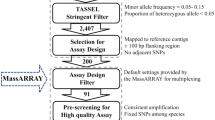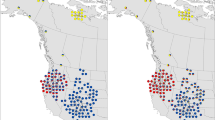Abstract
The Smallmouth Bass (Micropterus dolomieu; SMB) is a widely distributed black bass species, but the southwestern edge of the species range within the Interior Highlands contains some of the most divergent ecotypes. The Neosho subspecies (M. d. velox) inhabits tributaries of the Arkansas River within the Ozark Mountains and a second lineage is reported from drainages of the Ouachita Mountains. We sought to develop a single nucleotide polymorphism (SNP) panel to (1) diagnose hybridization with sympatric Spotted Bass (Micropterus punctulatus; SPB) and non-native Northern SMB (M. d. dolomieu) stocked in the region, and (2) delineate population structure within the ranges of the Neosho and Ouachita SMB lineages. We obtained 76 individual SMB samples from across their range but concentrated within the Interior Highlands (n = 50). We also included 3 SPB to allow for hybrid detection and 3 Shoal Bass (Micropterus cataractae) as an outgroup. Phylogenetic trees constructed with the generated SNP data corroborated the existence of at least three major lineages of SMB (Northern, Neosho, and Ouachita), each containing varying degrees of differentiation among major drainages. Simulation analyses revealed that chosen SNPs had high power (> 0.9) to assign SMB × SPB hybrid categories and similarly high power (> 0.8) for Northern SMB × Interior Highlands SMB hybrids. Clustering methods delineated major inter-basin population structure within the native ranges of Neosho and Ouachita SMB with chosen SNPs. Anticipated uses of the resulting 192-loci SNP panel include conservation planning, fisheries management assessments, and ecological investigations of the Neosho and Ouachita SMB lineages.





Similar content being viewed by others
References
Alvarez AC, Peterson D, Taylor AT, Tringali MD, Barthel BL (2015) Distribution and amount of hybridization between Shoal Bass and invasive Spotted Bass in the lower Flint River, Georgia. In: Tringali MD, Long JM, Birdsong TW, Allen MS (eds) Black bass diversity: multidisciplinary science for conservation. American Fisheries Society, Symposium 82, Bethesda, Maryland, pp 503–521
Bagley JC, Mayden RL, Roe KJ, Holznagel W, Harris PM (2011) Congeneric phylogeographical sampling reveals polyphyly and novel biodiversity within black basses (Centrarchidae: Micropterus). Biol J Linn Soc 104:346–363
Baker WH, Johnston CE, Folkerts GW (2008) The Alabama Bass, Micropterus henshalli (Teleostei: Centrarchidae), from the Mobile River Basin. Zootaxa 1861:57–67
Baker WH, Blanton RE, Johnston CE (2013) Diversity within the Redeye Bass, Micropterus coosae (Perciformes: Centrarchidae) species group, with descriptions of four new species. Zootaxa 3635:379–401
Barthel BL, Porak WF, Tringali MD, Phillipp DP (2015) Range-wide genetic evaluation of the Suwannee Bass reveals divergent lineages and evidence of small founding populations. In: Tringali MD, Long JM, Birdsong TW, Allen MS (eds) Black bass diversity: multidisciplinary science for conservation. American Fisheries Society, Symposium 82, Bethesda, Maryland, pp 659–677
Birdsong TW et al (2015) Native black bass initiative: implementing watershed-scale approaches to conservation of endemic black bass and other native fishes in the southern United States. In: Tringali MD, Long JM, Birdsong TW, Allen MS (eds) Black bass diversity: multidisciplinary science for conservation. American Fisheries Society, Symposium 82, Bethesda, Maryland, pp 636–378
Borden WC, Krebs RA (2009) Phylogeography and postglacial dispersal of Smallmouth Bass (Micropterus dolomieu) into the Great Lakes. Can J Fish Aquat Sci 66:2142–2156
Boxrucker J, Echelle AA, Van Den Bussche RA (2004) Determining the degree of hybridization in the Smallmouth Bass population of Broken Bow Reservoir and the Mountain Fork River. Final Report F-50-R, Project 19. Oklahoma Department of Wildlife Conservation, Oklahoma City
Brewer SK, Long JM (2015) Biology and ecology of Neosho Smallmouth Bass and the genetically distinct Ouachita lineage. In: Tringali MD, Long JM, Birdsong TW, Allen MS (eds) Black bass diversity: multidisciplinary science for conservation. American Fisheries Society, Symposium 82, Bethesda, Maryland, pp 281–295
Brewer SK, Orth DJ (2015) Smallmouth Bass Micropterus dolomieu Lacepède, 1802. In: Tringali MD, Long JM, Birdsong TW, Allen MS (eds) Black bass diversity: multidisciplinary science for conservation. American Fisheries Society, Symposium 82, Bethesda, Maryland, pp 9–26
Cofer LM (1995) Invalidation of the Wichita Spotted Bass, Micropterus punctulatus wichitae, subspecies theory. Copeia 1995:487–490
Coughlin WD, Echelle AA, Van Den Bussche RA, Cofer LM, Fisher WL (2003) Genetic structure of Spotted Bass (Micropterus punctulatus) in the Red and Arkansas River Basins: microsatellite and mitochondrial DNA variation. Southwest Nat 48:526–533
Earl DA, vonHoldt BM (2012) STRUCTURE HARVESTER: a website and program for visualizing STRUCTURE output and implementing the Evanno method. Conserv Genet Res 4:359–361
Eaton DA (2014) PyRAD: assembly of de novo RADseq loci for phylogenetic analyses. Bioinformatics 30:1844–1849
Faust E, Halvorsen KT, Andersen P, Knutsen H, André C (2018) Cleaner fish escape salmon farms and hybridize with local wrasse populations. R Soc Open Sci 5:171752
Felsenstein J (1985) Confidence limits on phylogenies: an approach using the bootstrap. Evolution 39:783–791
Garrett GP, Birdsong TW, Bean MG, McGillicuddy R (2015) Guadalupe Bass Restoration Initiative. In: Tringali MD, Long JM, Birdsong TW, Allen MS (eds) Black bass diversity: multidisciplinary science for conservation. American Fisheries Society, Symposium 82, Bethesda, Maryland, pp 379–385
Gunn JC, Berkman LK, Koppelman J, Taylor AT, Brewer S, Long JM, Eggert LS (2020) Complex patterns of genetic and morphological differentiation in the Smallmouth Bass subspecies (Micropterus dolomieu dolomieu and M. d. velox) of the Central Interior Highlands. Conserv Genet. https://doi.org/10.1007/s10592-020-01295-1
Dakin EE, Porter BA, Freeman BJ, Long JM (2015) Hybridization threatens Shoal Bass populations in the upper Chattahoochee River Basin. In: Tringali MD, Long JM, Birdsong TW, Allen MS (eds) Black bass diversity: multidisciplinary science for conservation. American Fisheries Society, Symposium 82, Bethesda, Maryland, pp 491–501
Hubbs CL, Bailey RM (1940) A revision of the black basses (Micropterus and Huro) with description of four new forms. Miscellaneous Publication of Museum of Zoological University of Michigan 48
Jombart T (2008) Adegenet: a R package for the multivariate analysis of genetic markers. Bioinformatics 24:1403–1405
Jombart T, Ahmed I (2011) Adegenet 1.3-1: new tools for the analysis of genome-wide SNP data. Bioinformatics. https://doi.org/10.1093/bioinformatics/btr521
Jombart T, Collins C (2015) A tutorial for discriminant analysis of principal components (DAPC) using adegenet 2.0.0. Imperial College London, MRC Centre for Outbreak Analysis and Modelling, London
Kassler TW, Koppelman JB, Near TJ, Dillman CB, Levengood JM, Swofford DL, VanOrman JL, Claussen JE, Philipp DP (2002) Molecular and morphological analyses of the black basses: implications for taxonomy and conservation. In: Philipp DP, Ridgway MS (eds) Black bass ecology, conservation, and management. American Fisheries Society Symposium 31, Bethesda, Maryland, pp 291–322
Kopelman NM, Mayzel J, Jakobsson M, Rosenberg NA, Mayrose I (2015) Clumpak: a program for identifying clustering modes and packaging population structure inferences across K. Mol Ecol Res 15:1179–1191
Koppelman JB (2015) Black bass hybrids: a natural phenomenon in an unnatural world. In: Tringali MD, Long JM, Birdsong TW, Allen MS (eds) Black bass diversity: multidisciplinary science for conservation. American Fisheries Society, Symposium 82, Bethesda, Maryland, pp 467–479
Kumar S, Stecher G, Li M, Knyaz C, Tamura K (2018) MEGA X: Molecular Evolutionary Genetics Analysis across computing platforms. Mol Biol Evol 35:1547–1549
Long JM, Allen MS, Porak WF, Suski CD (2015) A historical perspective of black bass management in the United States. In: Tringali MD, Long JM, Birdsong TW, Allen MS (eds) Black bass diversity: multidisciplinary science for conservation. American Fisheries Society, Symposium 82, Bethesda, Maryland, pp 99–122
Malloy TP (2001) Introgressive hybridization between native and non-native Smallmouth Bass in Oklahoma. Dissertation, Oklahoma State University
Mayden RL (1985) Biogeography of Ouachita Highland fishes. Southwest Nat 30:195–211
Mayden RL (1988) Vicariance biogeography, parsimony, and evolution in North American freshwater fishes. Syst Zool 37:329–355
Nei M, Kumar S (2000) Molecular evolution and phylogenetics. Oxford University Press, New York
Page LM, Espinosa-Perez H, Findley LT, Gilbert CR, Lea RN, Mandrak NE, Mayden RL, Nelson JS (2013) Common and scientific names of fishes from the United States, Canada, and Mexico, 7th edn. American Fisheries Society, Special Publication 34, Bethesda
Pritchard JK, Stephens M, Donnelly P (2000) Inference of population structure using multilocus genotype data. Genetics 155:945–959
Saitou N, Nei M (1987) The neighbor-joining method: a new method for reconstructing phylogenetic trees. Mol Biol Evol 4:406–425
Snow JR (1975) Hatchery propagation of the black basses. In: Stroud RH, Clepper H (eds) Black bass biology and management. Sport Fishing Institute, Washington, DC, pp 344–356
Stark WJ, Echelle AA (1998) Genetic structure and systematics of Smallmouth Bass, with emphasis on Interior Highlands populations. Trans Am Fish Soc 127:393–416
Stepien CA, Karsiotis SI, Sullivan TJ, Klymus KE (2017) Population genetic structure and comparative diversity of Smallmouth Bass Micropterus dolomieu: congruent patterns from two genomes. J Fish Biol 90:2125–2147
Tamura K (1992) Estimation of the number of nucleotide substitutions when there are strong transition-transversion and G+C-content biases. Mol Biol Evol 9:678–687
Tamura K, Kumar S (2002) Evolutionary distance estimation under heterogeneous substitution pattern among lineages. Mol Biol Evol 19:1727–1736
Tamura K, Nei M, Kumar S (2004) Prospects for inferring very large phylogenies by using the neighbor-joining method. Proc Natl Acad Sci USA 101:11030–11035
Taylor AT, Long JM, Schwemm MR, Tringali MD, Brewer SK (2016) Identification of Neosho Smallmouth Bass (Micropterus dolomieu velox) stocks for possible introduction into Grand Lake, Oklahoma. U.S. Fish and Wildlife Service, Cooperator Science Series #121-2016
Taylor AT, Long JM, Tringali MD, Barthel BL (2019) Conservation of black bass diversity: an emerging management paradigm. Fish 44:20–36
Taylor AT, Long JM, Schwemm MR, Brewer SK (2018a) Hybridization and genetic structure of Neosho Smallmouth Bass in the Ozark Highlands. N Am J Fish Manag 38:1226–1240
Taylor AT, Tringali MD, Sammons SM, Ingram TR, O’Rouke PM, Peterson DL, Long JM (2018b) Genetic structure of Shoal Bass within their native range. N Am J Fish Manag 38:549–564
Thongda W, Lewis M, Zhao H, Bowen B, Lutz-Carrilo DJ, Peoples BK, Peatman E (2019) Species-diagnostic SNP markers for the black basses (Micropterus spp.): a new tool for black bass conservation and management. Conserv Genet Res. https://doi.org/10.1007/s12686-019-01109-8
USFWS (2016) 2016 National Survey of Fishing, Hunting, and Wildlife-Associated Recreation. https://wsfrprograms.fws.gov/subpages/nationalsurvey/nat_survey2016.pdf. Accessed 7 Nov 2019
Williams JD, Burgess GH (1999) A new species of bass, Micropterus cataractae (Teleostei: Centrarchidae), from the Apalachicola River Basin in Alabama, Florida, and Georgia. Bull Fla Mus Nat Hist 42:81–114
Wringe BF, Stanley RR, Jeffery NW, Anderson EC, Bradbury IR (2017) Parallelnewhybrid: an R package for the parallelization of hybrid detection using newhybrids. Mol Ecol Res 17:91–95
Acknowledgements
For contributing fin clips: Jeff Buckingham, Aaron Kern, John Deller, Dray Carl, Mark Rogers, Ashley Nealis, Randy Jackson, Colt Holley, and Joel Bjornen. For constructive review prior to publication, we thank M. Lewis. This study was performed, in part, under the auspices of Oklahoma State University’s Institutional Animal Care and Use Committee’s Protocol # AG-13-8. Any use of trade, firm, or product names is for descriptive purposes only and does not imply endorsement by the U.S. Government. Funding was provided by the Oklahoma Cooperative Fish and Wildlife Research Unit (U.S. Geological Survey, Oklahoma State University, Oklahoma Department of Wildlife Conservation, Wildlife Management Institute, and U.S. Fish and Wildlife Service, cooperating).
Author information
Authors and Affiliations
Corresponding author
Ethics declarations
Conflict of interest
The authors declare that they have no conflict of interest.
Additional information
Publisher's Note
Springer Nature remains neutral with regard to jurisdictional claims in published maps and institutional affiliations.
Electronic supplementary material
Below is the link to the electronic supplementary material.
Rights and permissions
About this article
Cite this article
Long, J.M., Taylor, A.T. & Buonaccorsi, V. A conservation-oriented SNP panel for Smallmouth Bass (Micropterus dolomieu), with emphasis on Interior Highlands lineages. Conservation Genet Resour 13, 47–59 (2021). https://doi.org/10.1007/s12686-020-01170-8
Received:
Accepted:
Published:
Issue Date:
DOI: https://doi.org/10.1007/s12686-020-01170-8




